Remote Mirroring
Describes the concept and purpose of remote mirror volumes.
A remote mirror volume is a mirror volume with a source in another cluster. You can use remote mirrors for offsite backup, for data transfer to remote facilities, and for load and latency balancing for large websites. By mirroring the cluster's root volume and all other volumes in the cluster, you can create an entire mirrored cluster that keeps in sync with the source cluster.
Backup mirrors for disaster recovery can be located on physical media outside the cluster, or in a remote cluster. If disaster strikes the source cluster, you can check the time of last successful synchronization to determine the freshness of the backup (see Mirror Status).
Once data volumes are created in a primary data center, the Data Fabric administrator creates mirror volumes in a remote secondary data center. The following diagram illustrates the mirror relationship between these two volumes:
